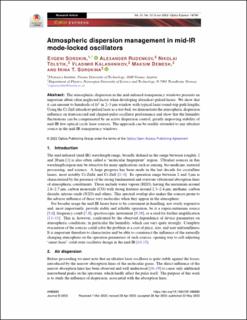| dc.contributor.author | Sorokin, Evgeni | |
| dc.contributor.author | Rudenkov, Alexander | |
| dc.contributor.author | Tolstik, Nikolai | |
| dc.contributor.author | Kalashnikov, Vladimir | |
| dc.contributor.author | Demesh, Maksim | |
| dc.contributor.author | Sorokina, Irina | |
| dc.date.accessioned | 2023-11-17T09:10:46Z | |
| dc.date.available | 2023-11-17T09:10:46Z | |
| dc.date.created | 2023-08-18T09:21:24Z | |
| dc.date.issued | 2023 | |
| dc.identifier.citation | Optics Express. 2023, 31 (12), 18790-18798. | en_US |
| dc.identifier.issn | 1094-4087 | |
| dc.identifier.uri | https://hdl.handle.net/11250/3103138 | |
| dc.description.abstract | The atmospheric dispersion in the mid-infrared transparency windows presents an important albeit often neglected factor when developing ultrashort-pulsed lasers. We show that it can amount to hundreds of fs2 in 2–3 µm window with typical laser round-trip path lengths. Using the Cr:ZnS ultrashort-pulsed laser as a test-bed, we demonstrate the atmospheric dispersion influence on femtosecond and chirped-pulse oscillator performance and show that the humidity fluctuations can be compensated by an active dispersion control, greatly improving stability of mid-IR few-optical cycle laser sources. The approach can be readily extended to any ultrafast source in the mid-IR transparency windows. | en_US |
| dc.language.iso | eng | en_US |
| dc.publisher | Optica Publishing Group | en_US |
| dc.title | Atmospheric dispersion management in mid-IR mode-locked oscillators | en_US |
| dc.title.alternative | Atmospheric dispersion management in mid-IR mode-locked oscillators | en_US |
| dc.type | Peer reviewed | en_US |
| dc.type | Journal article | en_US |
| dc.description.version | publishedVersion | en_US |
| dc.rights.holder | Open Access | en_US |
| dc.source.pagenumber | 18790-18798 | en_US |
| dc.source.volume | 31 | en_US |
| dc.source.journal | Optics Express | en_US |
| dc.source.issue | 12 | en_US |
| dc.identifier.doi | 10.1364/OE.488683 | |
| dc.identifier.cristin | 2167853 | |
| cristin.ispublished | true | |
| cristin.fulltext | original | |
| cristin.qualitycode | 2 | |
